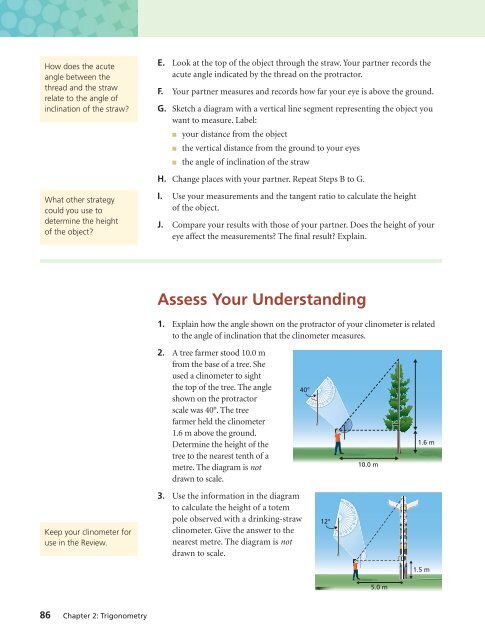SCIENCE WORLD This building was constructed for the Expo '86 ...
SCIENCE WORLD This building was constructed for the Expo '86 ...
SCIENCE WORLD This building was constructed for the Expo '86 ...
You also want an ePaper? Increase the reach of your titles
YUMPU automatically turns print PDFs into web optimized ePapers that Google loves.
How does <strong>the</strong> acute<br />
angle between <strong>the</strong><br />
thread and <strong>the</strong> straw<br />
relate to <strong>the</strong> angle of<br />
inclination of <strong>the</strong> straw?<br />
What o<strong>the</strong>r strategy<br />
could you use to<br />
determine <strong>the</strong> height<br />
of <strong>the</strong> object?<br />
Keep your clinometer <strong>for</strong><br />
use in <strong>the</strong> Review.<br />
86 Chapter 2: Trigonometry<br />
E. Look at <strong>the</strong> top of <strong>the</strong> object through <strong>the</strong> straw. Your partner records <strong>the</strong><br />
acute angle indicated by <strong>the</strong> thread on <strong>the</strong> protractor.<br />
F. Your partner measures and records how far your eye is above <strong>the</strong> ground.<br />
G. Sketch a diagram with a vertical line segment representing <strong>the</strong> object you<br />
want to measure. Label:<br />
■ your distance from <strong>the</strong> object<br />
■ <strong>the</strong> vertical distance from <strong>the</strong> ground to your eyes<br />
■ <strong>the</strong> angle of inclination of <strong>the</strong> straw<br />
H. Change places with your partner. Repeat Steps B to G.<br />
I. Use your measurements and <strong>the</strong> tangent ratio to calculate <strong>the</strong> height<br />
of <strong>the</strong> object.<br />
J. Compare your results with those of your partner. Does <strong>the</strong> height of your<br />
eye affect <strong>the</strong> measurements? The final result? Explain.<br />
Assess Your Understanding<br />
1. Explain how <strong>the</strong> angle shown on <strong>the</strong> protractor of your clinometer is related<br />
to <strong>the</strong> angle of inclination that <strong>the</strong> clinometer measures.<br />
2. A tree farmer stood 10.0 m<br />
from <strong>the</strong> base of a tree. She<br />
used a clinometer to sight<br />
<strong>the</strong> top of <strong>the</strong> tree. The angle<br />
shown on <strong>the</strong> protractor<br />
scale <strong>was</strong> 40°. The tree<br />
farmer held <strong>the</strong> clinometer<br />
1.6 m above <strong>the</strong> ground.<br />
Determine <strong>the</strong> height of <strong>the</strong><br />
tree to <strong>the</strong> nearest tenth of a<br />
metre. The diagram is not<br />
drawn to scale.<br />
3. Use <strong>the</strong> in<strong>for</strong>mation in <strong>the</strong> diagram<br />
to calculate <strong>the</strong> height of a totem<br />
pole observed with a drinking-straw<br />
clinometer. Give <strong>the</strong> answer to <strong>the</strong><br />
nearest metre. The diagram is not<br />
drawn to scale.<br />
40°<br />
12°<br />
10.0 m<br />
1.6 m




